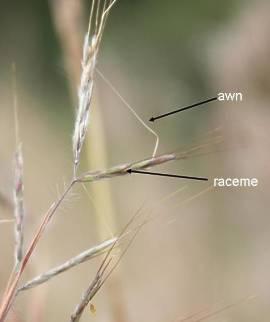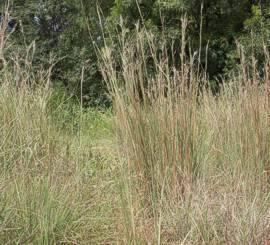Hyparrhenia hirta
Hyparrhenia hirta (L.) Stapf
Family: Poaceae
Common names: common thatching grass (Eng.); dektamboekiegras (Afr.)
Introduction
Hyparrhenia hirta is recognized by its hard basal tussock, rough narrow leaves and a scanty panicle of pairs of white villous racemes which do not deflex (bend downwards).

Description
Description
Hyparrhenia hirta is a wiry tufted perennial grass usually 300-800 mm high, rhizomatous and with slender culms. The leaf blade is 20-150 x 1-2(-4) mm. The panicle is scanty, consisting of 2-10 raceme pairs which are 20-40 mm long, never deflexed, bases unequal, cylindrical, 8-14 awns, 10-35 mm long, with hairs up to 0.3 mm long. The base of the upper raceme has 0-1 homogamous (same sex) pairs of spikelets. A sessile spikelet is 4.0-6.5 mm long, yellowish green to violet, white-villous and the callus is acute. The pedicelled spikelet is white villous and awnless. Flowering time: September to June. See glossary for terms in Gibbs Russell et al. (1990).

Conservation Status
Status
The SANBI Threatened Plants Programme has not, as yet, indicated its conservation status, but so far, Hyparrhenia hirta is widespread, and is good for grazing in spring and early summer, so conservation is practised indirectly.
Distribution and habitat
Distribution description
Hyparrhenia hirta is common in southern Africa and occurs throughout Africa to the Mediterranean region and Pakistan. It has also been introduced to other parts of the world. It occurs in open grassland, on rocky slopes and along rivers on most soil types, with a preference for well-drained, lighter textured granites to heavy black, stony soils.
It forms dense stands in disturbed areas such as uncultivated lands and roadsides where it can keep out other grasses for many years. The species occupies the largest area of road verges along the entire urban to rural gradient of southern Africa.
Derivation of name and historical aspects
History
Hyparrhenia is derived from the Greek words hypo, meaning under, and arren, meaning masculine, alluding to the male spikelets at the bases of the racemes. The species name hirta is from the Latin word meaning hairy, probably referring to the hairy spikelets.
The genus Hyparrhenia has ± 55 species, mostly in Africa, a few species in other tropical regions and the Mediterranean, and 20 in southern Africa, where it is widespread.
Ecology
Ecology
Pollination and seed dispersal of Hyparrhenia hirta are by wind.
Hyparrhenia hirta is the most competitive species in infertile areas, but not in areas where other fertile species occur. Once established, Hyparrhenia hirta is difficult to control.
Uses
Use
Hyparrhenia hirta is probably the most popular thatching grass used in South Africa. It is grazed by livestock early in the growing season and after fires, but becomes less palatable for grazing later. In South Africa and the USA this grass is seen as a drought resistant grass, which protects the soil and stabilizes hard, gravelly soil and eroded places. It is also used to weave mats and baskets.
Growing Hyparrhenia hirta
Grow
Hyparrhenia hirta is self-fertile, enabling new populations to arise from a single plant. Seed can germinate readily in different light regimes, over a wide range of temperatures, pH levels and under marginal water stress. Seedlings can emerge from a depth of up to 9 cm. Seedling recruitment can occur within established stands and in soil with a plant litter layer.

References
- Chippindall, L.K.A. & Crook, A.O. 1976. Grasses of southern Africa. Collins, Harare [ Salisbury ].
- Gibbs Russell, G.E., Watson, L., Koekemoer, M., Smook, L., Barker, N.P., Anderson, H.M. & Dallwitz, M.J. 1990. Grasses of southern Africa. Memoirs of the Botanical Survey of South Africa No. 58.
- Leistner, O.A. (ed.). 2000. Seeds plants of southern Africa: families and genera. Strelitzia 10. National Botanical Institute, Pretoria.
- Van Oudtshoorn, F. 1999. Guide to the grasses of southern Africa. Briza Publications, Pretoria.
Credits
Aluoneswi Caroline Mashau
Pretoria National Herbarium
April 2009
Plant Attributes:
Plant Type: Grass, Perennial
SA Distribution: Eastern Cape, Free State, Gauteng, KwaZulu-Natal, Limpopo, Mpumalanga, North West, Northern Cape, Western Cape
Soil type: Sandy, Clay, Loam
Flowering season: Spring, Early Summer
PH:
Flower colour: White
Aspect: Full Sun
Gardening skill: Average
Special Features:
Horticultural zones











Rate this article
Article well written and informative
Rate this plant
Is this an interesting plant?
Login to add your Comment
Back to topNot registered yet? Click here to register.